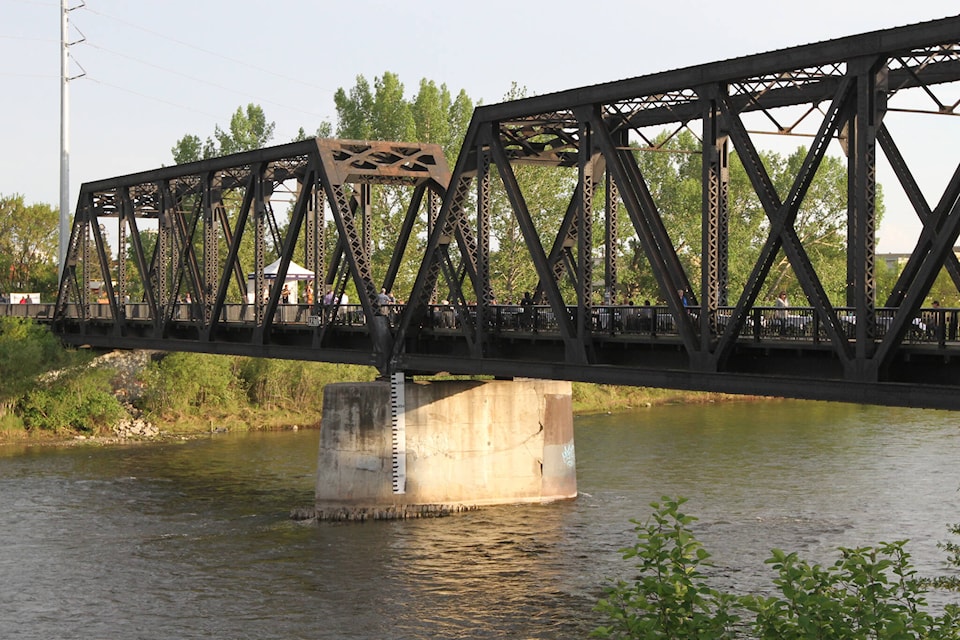Red Deer’s historic CPR pedestrian bridge, which is due for a $19 million upgrade, should be moved to connect Capstone with Bower Ponds, suggested a local developer.
Brian Squires is all for restoring the iron bridge from 1890, but believes spending that kind of money on new decking and supports would make more sense if the structure was moved to a more visible, higher-traffic location.
“It’s a beautiful bridge,” said Squires, of New Phase Developments Ltd., but is in the wrong place, leading “from uptown into the woods” in Riverside Meadows. He knows it’s prone to vandalism and other misuse.
At a time when city councillor Victor Doerksen is calling for a new pedestrian bridge to be built at Capstone to ignite riverside development, Squires believes moving the old CPR bridge to this more viable, visible location is “a no brainer.”
“Put it somewhere where it can be valued, where it would be well used, instead of abused,” said the developer. Squires can envision the CPR bridge lit up as a Christmastime Capstone attraction — or even for summertime wedding photos.
However, Greg Sikora, parks and public works manager for the City of Red Deer, said moving the massive, steel 160-metre long structure would be a logistically overwhelming and cost-prohibitive.
Moreover, the Red Deer River widens at Capstone, which would make the 160-metre long CPR bridge too short for the new spot, he said.
“It would be cheaper to build a new bridge at Capstone from scratch,” added Sikora, than transport a 50-foot wide, 40-foot tall riveted steel structure to Capstone.
The bridge couldn’t be towed up-river as it wouldn’t fit under Taylor Bridge and also couldn’t be moved by road or trail without being disassembled, he said.
Squires noted the historic Blackfriars Street Bridge in London, Ont. was lifted by cranes off the riverbank in 2017 for restoration work to be done at an off-site location. The iron bridge was then returned to span the river in 2018. He believes this project shows moving Red Deer’s CPR bridge could be done, from an engineering standpoint.
But Sikora said the 65-metre long Blackfriars bridge is much smaller and lighter than Red Deer’s CPR Bridge, which would have to be taken completely apart to move.
This would be no small task when each steel section is riveted together, he added. Each rivet would have to be drilled out and the steel sections bolted when the bridge is reassembled — a very expensive, time-consuming process.
There are also timing and historic elements to consider. Sikora said an $11 million federal grant approved for the project stipulates the work must be completed by early 2025 — and it is already expected to take a year or longer to obtain the necessary environmental approvals. He believes changing the parameters of the project would extend this process.
And losing the historic wooden trestles that currently anchor the bridge to the riverbank at either end would also raise the question of whether the CPR bridge would then still qualify for historic government funding.
Squires, a volunteer with the Citizens on Patrol bike group, remains concerned about illicit activities on that former Canadian Pacific Rail train bridge, and the spray-paint vandalism done at this out-of-the-way spot.
Red Deer city council recently approved adding $5.6 million towards the $3 million previously budgeted for the extensive restoration needed by the former train bridge to its decking as well as supports. $11 million for this project was also received from the federal government, for a total of $19 million.
With all of this money going to restoration, Squires is concerned the bridge will continue to be prone to abuse at its current site.
Sikora said parks officials will be working with stakeholders to see if brighter lighting or environmental design can be added to discourage illicit activities on the restored bridge. Some options, such as installing substratum lights, will have to be weighed against ecological concerns about keeping animal and insect migratory corridors darker.
Besides regular police patrols of the bridge, Sikora said City of Red Deer workers do regular cleanups along the bridge and under it, as well as reacting to public concerns and tips left on the Report-a-Problem line.
lmichelin@reddeeradvocate.com
Like us on Facebook and follow us on Twitter
